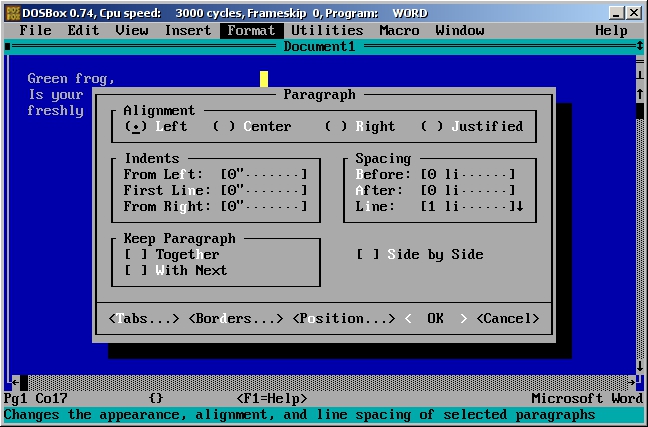Microsoft Word 5.5 was released sometime ago. It was supposed to be a Y2K fix, just an update really. What Microsoft did instead was release the entire application for download with no restrictions, for free.
As you can see, there really isn't much to it. So why would anyone in their right mind want to use 25 year old software? They wouldn't. However, most writers of fictions are probably not in their right mind, otherwise they would be accountants or something else with a stable pay check. For writers of fiction, this could be something great.
Word for DOS can be run in a program call "DOSBox". It can also be run in a Virtual Machine that is running DOS. These options would, on the surface anyway, seem to give you some advantages. You could enjoy sharing folders with a much newer operating system such as Windows 8, Ubuntu or even osX. You could have multiple copies open at the same time, each in its own window, doing its own thing. You could have research right along side what you are writing about.
But every major word processor for every new operating system, already does all that. So why use an antiquated version that is no longer supported? It is the ultimate in distraction free writing, that's why.
The best way to use Word for DOS, is by running DOS. Booting your computer into DOS forces you to use one application at a time. No task switching. Also, no interruptions by Facebook or email programs.
Of course, you probably don't have a floppy drive installed and booting from a live cd sounds good, until you need to save what you are writing. So what then is there to do? Create a bootable USB stick. Amazingly, SD Cards also work for this. In an upcoming post I will walk you through creating such a thing, and even provide a downloadable image you can use to create your own.
Once you boot into DOS, you will get a simple command prompt. Just type the word "word" and you are in. There is no font selection, there is only one font, pica. Even then that is the "printed" font. The font you see is called "system" and it is a fixed width font.
You can change some colors, and I suggest you do. You may be staring at this screen a lot. All I changed was the background to black, the rest I left alone. Play around with them for a while to get a feel for how it looks and works for you and your taste.
The point of such a simple interface is simple. Content creation. You are not publishing you work yet. You haven't even written it yet. You are not setting type face, margins, or any of that. It doesn't matter one little bit. The idea is to get as simple as possible so you can focus completely on the task of putting words to page. Nothing more, nothing less. Just writing.
Don't let the all this simplicity fool you though. Word 5.5 for DOS is very capable. It actually has "Windows" of sorts for working with multiple documents, a customizable dictionary and thesaurus. It also doesn't auto-replace or auto-correct anything nor does it auto-capitalize anything. This is a good thing if you are trying to use elvish words in your writing.
When you're done with your document, you can save it in one of two formats: RTF and DOC. So far I have opened RTF files in Word 2011 for Mac, Word Viewer for Windows, and Wordpad for Windows all without problems. The problem is the DOC format. If you have Windows and Microsoft Word for Windows you are golden. Simply download the converter and install it. The instructions are inside the self extracting archive. This, however, does not work for Word for Mac. Really though, for writing fiction, how much formatting do you need beyond what RTF will handle? These RTF files also import nicely into Word 2011 for Mac and into Scrivener.
If you are looking for the ultimate in distraction free writing, give Word for DOS a try. Really, what have you got to loose?
Until next time ...
